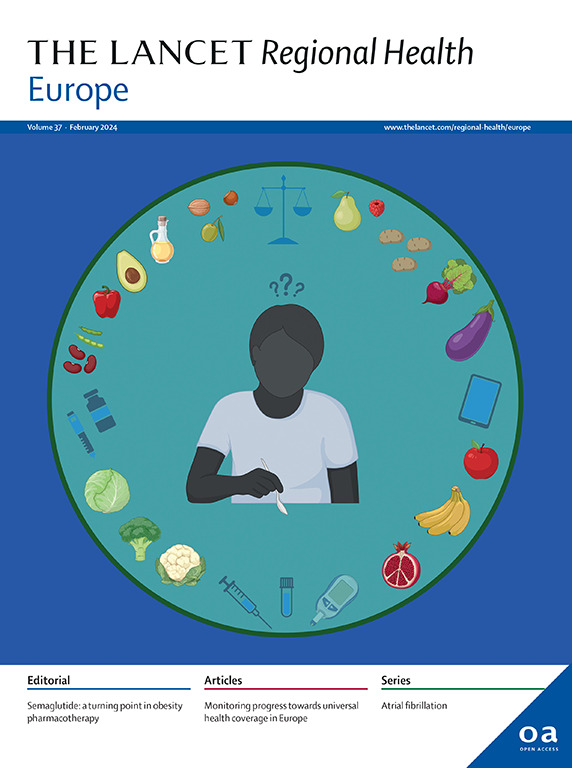Prevalence of myopia in Europe: a systematic review and meta-analysis of data from 14 countries
IF 13
Q1 HEALTH CARE SCIENCES & SERVICES
引用次数: 0
Abstract
Background
Although myopia prevalence increased in East Asian countries, the burden of myopia in Europe is less known. We performed a systematic review and meta-analysis to estimate the prevalence of myopia in Europe and at the country level.
Methods
We searched PubMed, Scopus and Web of Science to identify studies on myopia prevalence published until January 2024, regardless of language. We included European cross-sectional and cohort studies with defined sampling strategies and excluded clinical surveys, myopia registries, self-reported near-sightedness, and non-representative populations. Pooled prevalence was estimated using random-effects models. Heterogeneity was assessed using the Cochran's Q (χ2 test) and the I2 statistic. The study protocol was preregistered in PROSPERO (CRD42023471527).
Findings
We screened 2074 records and included 22 studies (from 14 European countries; n = 128,012) in the meta-analyses. The pooled prevalence of myopia was 23.5% (95% CI: 18.5–29.3; I2 = 99.7%), ranging from 11.9% in Finland to 49.7% in Sweden. In cycloplegic studies, myopia prevalence was 18.9% (95% CI: 13.2–26.5%; I2 = 99.7%) vs. 31.2% (95% CI: 24.9–38.3%; I2 = 99.3%) in non-cycloplegic studies. Subgroup and meta-regression analyses exploring sources of heterogeneity showed a lower prevalence in children (6–11 years; 5.5%) compared with adolescents (12–17 years; 25.2%) and adults (18–39 years; 24.3%) in cycloplegic studies. No significant differences in prevalence were observed between sexes. Myopia prevalence increased significantly between 2000–2010 and 2011–2022 (p = 0.040), although age-specific trends remained stable.
Interpretation
Myopia prevalence in Europe is lower than in Asia, with a less pronounced increase that disappears after stratifying by cycloplegic refraction and age. These findings highlight the need for age-specific data and cycloplegic refraction in future studies to reduce heterogeneity. Uneven country representation may limit the generalisability of these results.
Funding
The present publication was funded by Fundação Ciência e Tecnologia, IP national support through UID/04923—Comprehensive Health Research Centre.
欧洲近视患病率:来自14个国家数据的系统回顾和荟萃分析
虽然东亚国家的近视发病率有所上升,但欧洲的近视负担却鲜为人知。我们进行了系统回顾和荟萃分析,以估计欧洲和国家一级的近视患病率。方法:我们检索PubMed、Scopus和Web of Science,以确定截至2024年1月发表的有关近视患病率的研究,不论语言。我们纳入了具有明确抽样策略的欧洲横断面和队列研究,排除了临床调查、近视登记、自述近视和非代表性人群。使用随机效应模型估计合并患病率。采用Cochran’s Q (χ2检验)和I2统计量评估异质性。该研究方案在PROSPERO (CRD42023471527)中预注册。研究结果:我们筛选了2074项记录,包括22项研究(来自14个欧洲国家;N = 128,012)。合计近视患病率为23.5% (95% CI: 18.5-29.3;I2 = 99.7%),从芬兰的11.9%到瑞典的49.7%不等。在单眼麻痹的研究中,近视患病率为18.9% (95% CI: 13.2-26.5%;I2 = 99.7%) vs. 31.2% (95% CI: 24.9-38.3%;I2 = 99.3%)。探索异质性来源的亚组和元回归分析显示,儿童(6-11岁;5.5%),而青少年(12-17岁;25.2%)和成人(18-39岁;24.3%)。患病率在性别之间没有显著差异。在2000-2010年和2011-2022年期间,近视患病率显著增加(p = 0.040),尽管特定年龄的趋势保持稳定。欧洲的近视患病率低于亚洲,在按睫状体麻痹性屈光和年龄分层后,近视的增加不太明显。这些发现强调了在未来的研究中需要特定年龄的数据和睫状体麻痹性屈光以减少异质性。国家代表性不均衡可能限制这些结果的普遍性。本出版物由 技术基金会(Ciência e tecologia)资助,IP国家通过UID/04923 -综合卫生研究中心提供支持。
本文章由计算机程序翻译,如有差异,请以英文原文为准。
求助全文
约1分钟内获得全文
求助全文
来源期刊

Lancet Regional Health-Europe
Multiple-
CiteScore
19.90
自引率
1.40%
发文量
260
审稿时长
9 weeks
期刊介绍:
The Lancet Regional Health – Europe, a gold open access journal, is part of The Lancet's global effort to promote healthcare quality and accessibility worldwide. It focuses on advancing clinical practice and health policy in the European region to enhance health outcomes. The journal publishes high-quality original research advocating changes in clinical practice and health policy. It also includes reviews, commentaries, and opinion pieces on regional health topics, such as infection and disease prevention, healthy aging, and reducing health disparities.
 求助内容:
求助内容: 应助结果提醒方式:
应助结果提醒方式:


